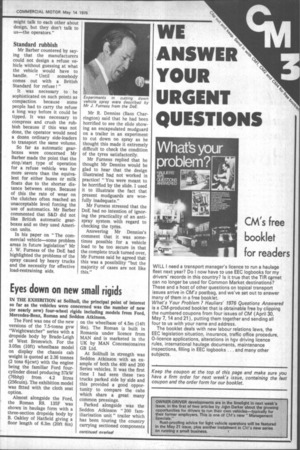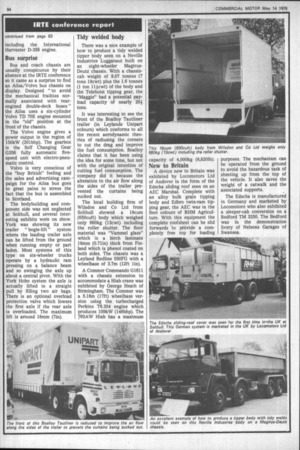Eyes down on new small rigids
Page 65

Page 66

If you've noticed an error in this article please click here to report it so we can fix it.
IN THE EXHIBITION at Solihull, the principal point of interest so far as the vehicles were concerned was the number of new (or nearly new) four-wheel rigids including models from Ford, Mercedes-Benz, Roman and Seddon Atkinson.
The Ford was one of the new versions of the 7.5-tonne gvw "Weightwatcher" series with a dropside body by Brade-Leigh of West Bromwich. For the 3.05m (10ft) wheelbase model on display the chassis cab weight is quoted at 2.36 tonnes (2 tons 6icwt) with the engine being the familiar Ford fourcylinder diesel producing 57kW (76bhp) from 4.2 litres (256cuin). The exhibition model was fitted with the cloth seat option.
Almost alongside the Ford, the Roman R8. 135F was shown in haulage form with a three-section dropside body by B. Oakley of Hatfield giving a floor length of 6.3m (20ft 8in) on the wheelbase of 4.5m (14ft 9in). The Roman is built in Romania under licence from MAN and is marketed in the UK by MAN Concessionaires GB Ltd.
At Solihull in strength was Seddon Atkinson with an example of both the 400 and 200 Series vehicles. It was the first time I had seen these two trucks parked side by side and this provided a good opportunity to compare the cabs which share a great many common pressings.
Parked alongside was the Seddon Atkinson "200 familiarisation unit " trailer which has been touring the country carrying sectioned components including the International Harvester D-358 engine.
Bus surprise
Bus and coach chassis are usually conspicuous by their absence at the IRTE conference so it came as a surprise to find an Ailsa/Volvo bus chassis on display. Designed "to avoid the mechanical frailties normally associated with rearengined double-deck buses " the Ailsa uses a six-cylinder Volvo TD 70E engine mounted in the "old" position at the front of the chassis.
The Volvo engine gives a power output in the region of 150kW (201bhp). The gearbox is the Self Changing Gear G356 fully automatic fivespeed unit with electro-pneumatic control.
Volvo is very conscious of the "buy British" feeling and the sales and advertising campaign for the Ailsa bus goes to great pains to stress the fact that the bus is assembled in Scotland.
The bodybuilding and component side was not neglected at Solihull, and several interesting exhibits were on show. York was showing its new trailer " bogie-lift " system where the leading trailer axle can be lifted from the ground when running empty or part laden. Most systems of this type on six-wheeler trucks operate by a hydraulic ram pressing on a balance beam and so swinging the axle up about a central pivot. With the York Hobo system the axle is actually lifted in a straight pull by filling two air bags. There is an optional overload protection valve which lowers the first axle if the rear axle is overloaded. The maximum lift is around 18mm (7in).
Tidy welded body
There was a nice example of how to produce a tidy welded tipper body seen on a Neville Industries Lugganaut built on an eight-wheeler MagirusDeutz chassis. With a chassiscab weight of 8.07 tonnes (7 tons 19cwt) plus the 1.6 tonnes (1 ton 11 cwt) of the body and the Telehoist tipping gear, the "Maggie" had a potential payload capacity of nearly 204 tons.
It was interesting to see the front of the Boalloy Tautliner trailer (in Leylands Unipart colours) which conforms to all the recent aerodynamic theories of radiusing the corners to cut the drag and improve the fuel consumption. Boalloy claims that it has been using the idea for some time, but not with the original intention of cutting fuel consumption. The company did it because the alteration to the air flow along the sides of the trailer prevented the curtains being sucked out.
The local building firm of Wilsdon and Co Ltd from Solihull showed a 18cum (650cuft) body which weighed only 660kg (13cwt) including the roller shutter. The floor material was "Vammel glass" which is a birch laminate 18mm (0.71in) thick from Finland which is phenol coated on both sides. The chassis was a Leyland Redline 550FG with a wheelbase of 3.7m (12ft lin).
A Commer Commando G1611 with a chassis extension to accommodate a Hiab crane was exhibited by George Heath of Birmingham. The Commer was a 5.18m (17ft) wheelbase version using the turbocharged Perkins T6.354 engine which produces 109kW (146bhp). The 765AW Hiab has a maximum capacity of 4,000kg (8,8201b).
New to Britain
A device new to Britain was exhibited by Locomotors Ltd of Andover in the form of the Edscha sliding roof seen on an AEC Marshal. Complete with an alloy bulk grain tipping body and Edbro twin-ram tipping gear, the AEC was in the fleet colours of RHM Agriculture. With this equipment the complete roofsheet can be slid forwards to provide a completely free top for loading purposes. The mechanism can be operated from the ground to avoid the hazardous task of sheeting up from the top of the vehicle. It also saves the weight of a catwalk and the associated supports.
' The Edscha is manufactured in Germany and marketed by Locomotors who also exhibited a sleeper-cab conversion on a Bedford TM 3250. The Bedford was in the demonstration livery of Nelsons Garages of Swansea.




























































































































































































































